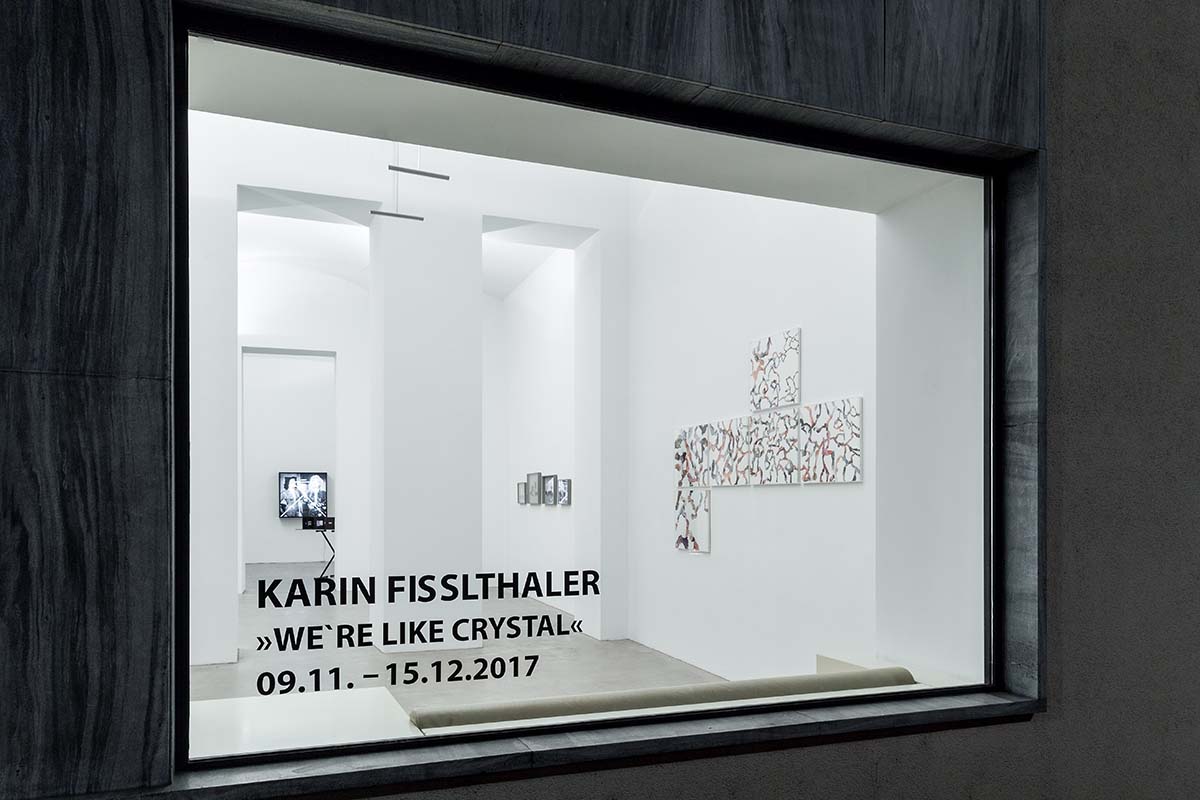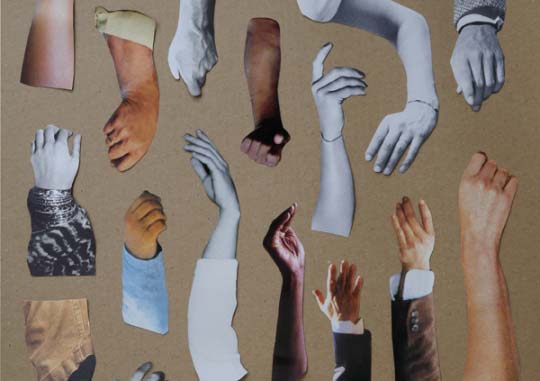„We’re like crystal, we break easy“
This is the melancholic metaphor that opens the song by the rock band New Order, released in 2001. Contrary to the programmatic label, the text tells of the instability of relationships and an immense yearning for love. The never-ending call “keep it coming, keep it coming” leaves the image of an emotionally unfulfilled world that has lost its closeness.
It seems that Karin Fisslthaler is looking for a visual echo to this metaphor in her artistic work. Deeply cinematically influenced, one thing resonates above all else for her in the picture of the crystal: the Deleuzian definition of the filmic crystal image with its thousand-fold refractions. As such, the philosopher describes situations on the canvas in which what is currently experienced, past and imagined appears alongside each other, superimposes itself or penetrates to the point of dissolution. Things that seem to have been taken from other times and spaces are particularly important. On the back of them, memories and associations unfold. They break open the experience of the present. At the same time, however, they enclose the individual in his or her personal experience horizon. Threats to subjective stability or, in other words, the fragility of human existence are also an issue here.
The work Kollektion is a good example of how the artist realises Deleuz’s film theory. The title comes from the fashion industry and refers to a coordinated compilation of samples. However, the “commodity” that Fisslthaler is dealing with is of a highly unusual nature. In the depths of a small showcase, hands and arms of different lengths spread out. With the greatest precision and the finest instruments, she has separated out the artist from printed works that she finds in waste paper, antiquarian bookshops and flea markets. Removed from the cycle of everyday life, they have not yet found their way into a well-ordered archive,. In their papery corporeality, coloured and black and white, these “cut outs” bear the fingerprints of a recently lived life. In addition, there is the fact that they are not fixed flat on a neutral substrate. Freely moveable and haptically experienceable, they claim the right to an independent existence. After all, they are unique. And even more: gestures and signs very concretely mould the invisible objects of their desires. The stimulation could not be greater! Torn out of foreign bodies, they express themselves as surrogates of various different life situations. The mysterious realm of collective memories that have not yet been processed opens up. We seem to have encountered every single arm once. Fisslthaler fishes in the pool of our imaginations.
The suggestive power of the two small-format work complexes Exhausted Hands and Silent Treatmentis even stronger. Here the artist has used larger extracts and provides the eye with further indications of the spheres in which the hands are acting. She works in series, arranging a visual encyclopaedia of typical everyday events, similar to Hans Eijkelboom. But while the Dutch artist places his portraits side by side in series as “inventory shots of the street” (Sabine Vogel) in the usual format of pictorial archives, and thereby exposes the utopia of urban individualism, Fisslthaler, like a director, carefully stages each and every one of her by the way “headless” excerpts, or even better: she performs them! She brings them onto the stage of miniature showpieces! The letting go of naked hands, for example, takes place in the protected intimacy of different-sized matchboxes. Some things even remain hidden from view, because they are only half raised. The hands of power-conscious men stuck in their trouser pockets, in contrast, appear in the window panel of a vertical-format envelope. We know these “props” in the standard format from the regulated office world. The ranking suggests uniformity and the dictates of social conventions.
The artist proceeds differently in the series Social Network. Here, too, she draws from the repertoire of cut-out hands, but she combines them into a large collage. The series of six equal-size surfaces measuring 65 x 50 cm is almost ornamentally continued. It gives the impression of a strangely disembodied, externally moved human chain. The meeting of two hands, the famous handshake, only occasionally succeeds. Rather, a blind grasping predominates, sometimes also grasping at nothing or hanging together without any apparent aim. Sometimes the chain performs tricks, and circles in small groups. Other hands remain excluded and find their way by touching themselves.
The hand print is one of the earliest forms of human expression. It is the oldest signature of Homo sapiens, indexical and self-referential at the same time. This cultural practice alone proves that the consciously used potential of a hand is one of the pillars of civilisation. Beyond the function of a mere tool, the hand has always been and still is an important instrument for gaining knowledge: sensations of subjective perception as well as processes of objective comprehension take place on its sensitive inner surface. Internal and external perception nestle against each other. Counting is ultimately also a faculty of the fingers. Essentially, however, hands have always served as a non-verbal and universal medium of expression. They are used to articulate unconscious and culturally coded content. The function of this sensory organ has changed as a result of the digital revolution however: the eye and the hand now belong to separate worlds of experience. The fingertips on the smooth surfaces of a computer keyboard do not understand what the screen offers to the eye. They are also losing value in communication. Handless emojis have flooded the screen since the 1990s. One could call it the emancipation of the face from the hand, but even more so: the face is becoming the preferred place of non-verbal communication everywhere. Again it is film that has long been preparing us for this. Today we read from faces and not from hands any more.
Fisslthaler draws attention to these loss-making developments in various works. In the series einsamer Ort for example, she cuts a film still from the 1950 feature film of the same name. The close-up captures the tense moment in which the well-known characters have to decide for or against a farewell. It is night; both of them are sitting in a car, he has taken his hands off the steering wheel, puts his arm around her shoulders, looking at her expectantly, his eyes are in the dark. The spotlight, on the other hand, mercilessly bathes her soft features in bright light, leaving no doubt: it is up to her to find an answer. Nevertheless, her face reveals nothing more than a look that – directed inwards – is weighing up a whole life. The subject is a telling non-communication. This is where Fisslthaler’s dissecting scissors come in. She cuts through the quarrelsome couple and places the silenced ones at the outermost edge on either side of an empty centre of the picture. Thus the sides are swapped and she, on whose face all eyes rest, now sits on the side with the steering wheel. In this dissociation, the intensity of the refused glances into the immeasurable increases. With the void between them, Fisslthaler stages the unspeakable; what is written on their faces without words and hands that would be able to redeem it at that moment, an infinite distance.
But to go back to the Social Network. Here the faceless communication of hands seems to be developing uncontrollably in all directions. Contact happens without physical emphasis. Observed proximity is not real closeness. Real closeness rather eludes the sense of sight. The Social Network that connects many screens – operated by lonely hands – could soon span the entire globe, but it will not correspond to your real experience. Fisslthaler thus not only questions the possibilities of experience of globality, but of wholeness itself. The insight into the incompleteness of human cognitive capacity, which the world in its growing complexity only reveals itself in fragments of unconnected facets of perception, and in particular the insight that even the wholeness of an individual is not a real, experienceable quantity permeates the artist’s entire work. Fisslthaler’s world remains a fragile crystal image.
(Heidrun Rosenberg, October 2017)













